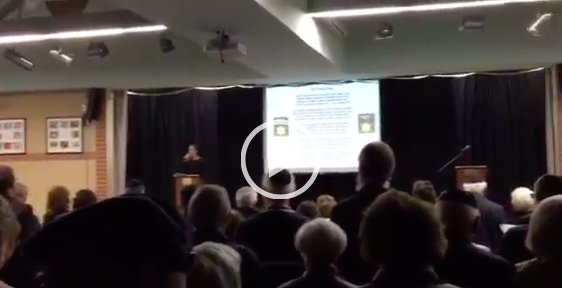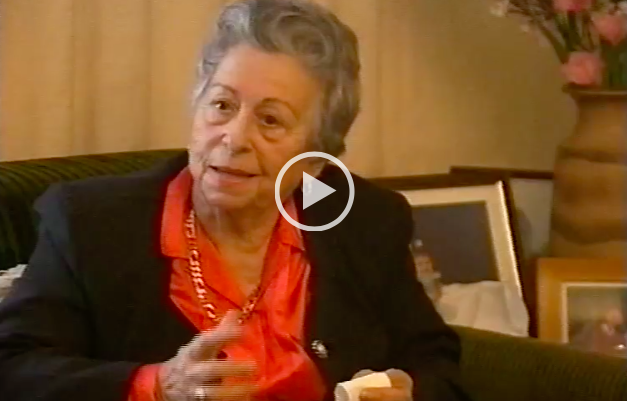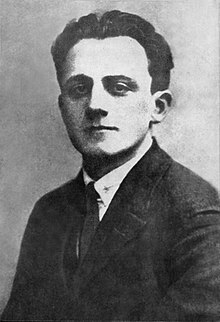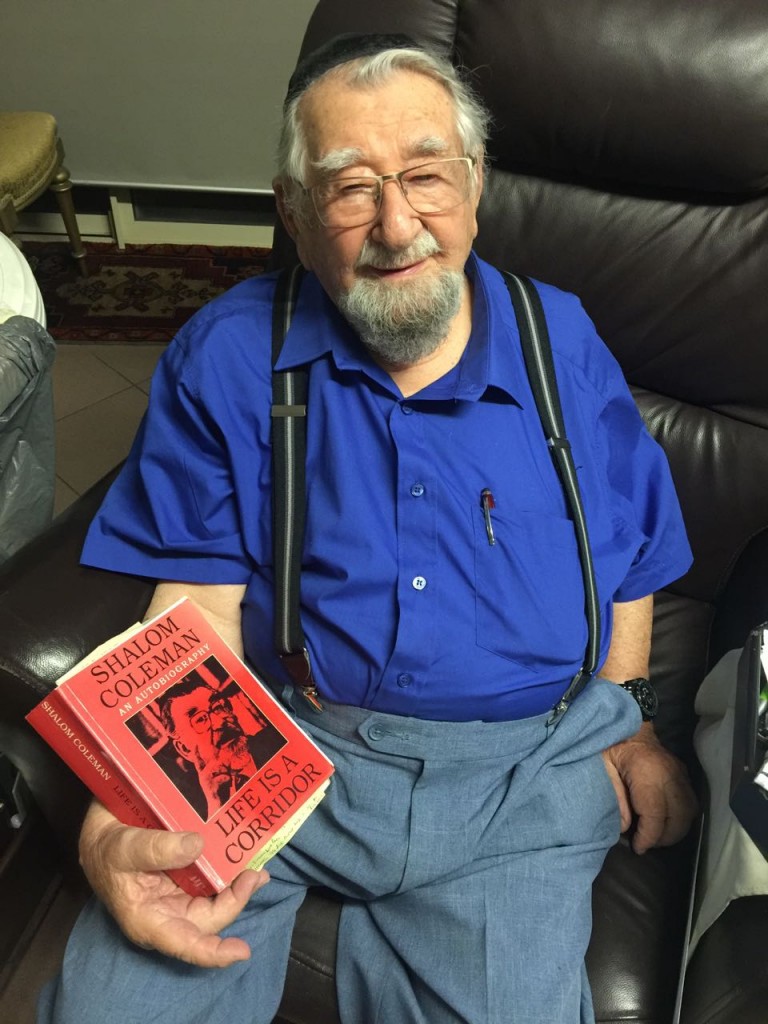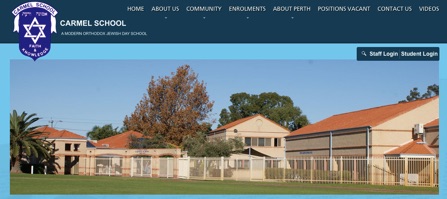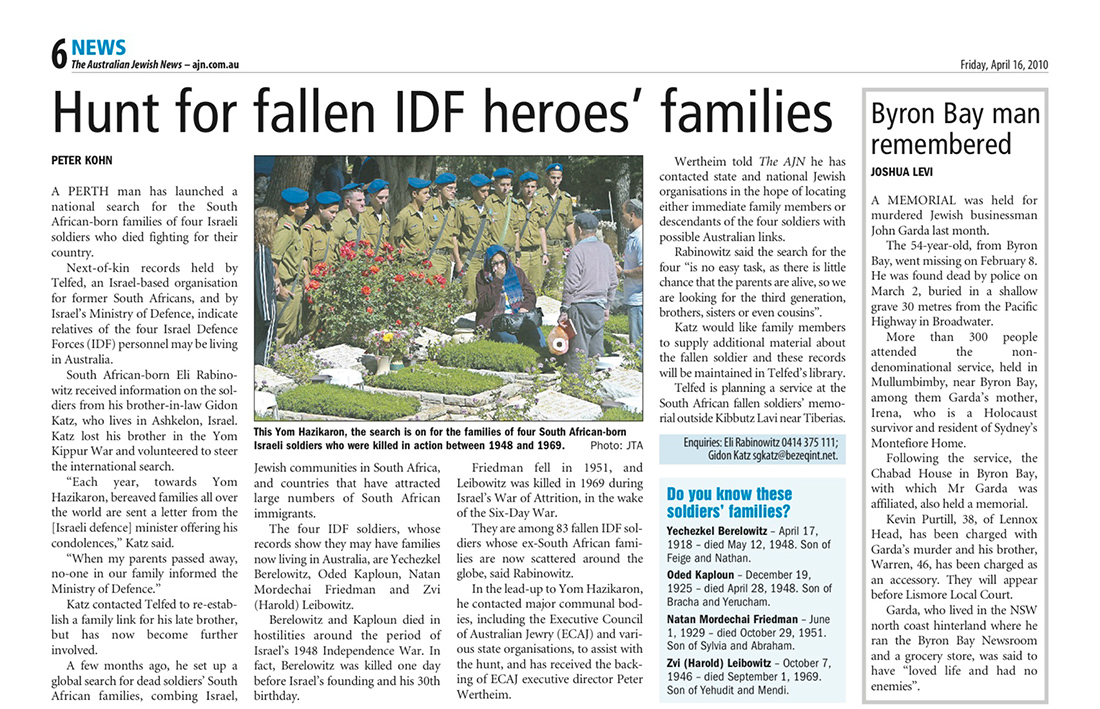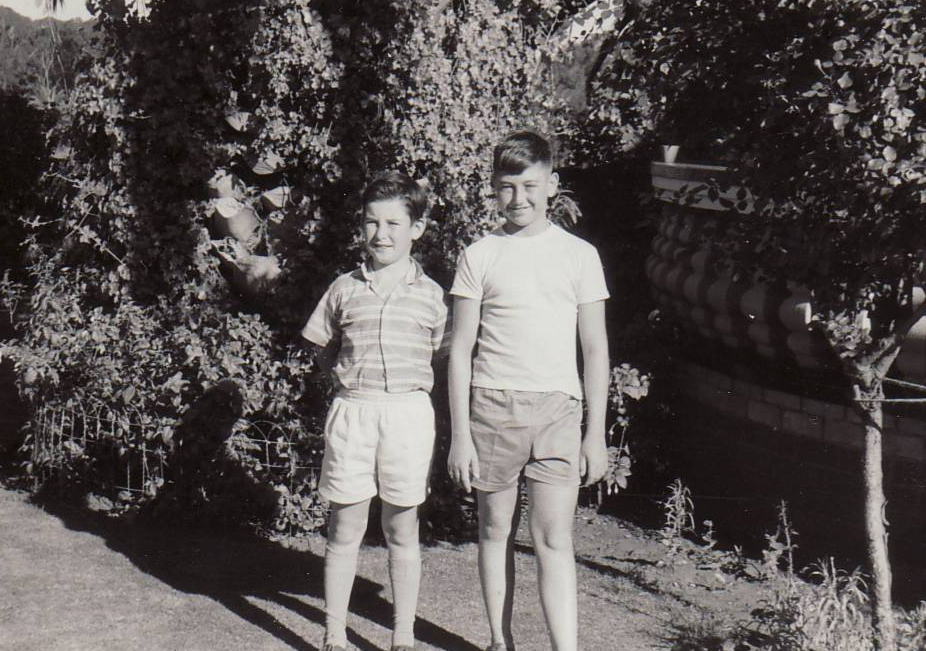Every year, on the National Day of Mourning for those who have fallen while serving the country, we, the Southern African Jews in Israel, collectively remember the eighty seven fallen from our community.
Their names are engraved on a memorial wall in the heart of the JNF-KKL Lavi forest close to the Golani junction, on a plaque in the offices of the SAZF in Raanana and appear at the end of this article.
For the grieving families each name encapsulates the individual life story of their beloved sons and daughters. But those names do more than that. They tell the story of Israel’s long battle for safety and security in an often hostile neighbourhood.
That is the story I would like to tell. Gidon Katz, who lost a brother in the Yom Kippur War and who was largely behind the restoration of the stone monument alongside the wall of names, provided me with details of all eighty six fallen. As I read them and made my own notes I realised to what extent these eighty six soldiers not only fought in all Israel’s wars but are a cross section of Israeli society.
Some came on aliya with their parents; some came on their own immediately after completing school; some were Sabras whose parents had come on aliya; some studied in universities both in Israel and abroad.
Some were very young, still doing their national service while others were much older, serving in the reserves. Prior to the establishment of the State of Israel they served in the Irgun (Etzel), the Hagana and the Palmach, and thereafter they served in the paratroopers, the armoured corps, the artillery, the navy and the air force and a few had even served in the SA air force and navy. They were in Nachal, in Givati, in the Security Services and in the border police.
Some were career soldiers and officers, others were promoted posthumously. Many were outstanding soldiers in the courses in which they participated and some were awarded medals of valour for their bravery beyond the call of duty. One fell in a training accident in the US, while the family of another donated his organs to seven recipients.
Some were not yet married while others left young, heartbroken wives. Some had not had time to have children while one left seven devastated orphans. They lived in cities, in villages, on kibbutzim and moshavim, within the 1949 cease-fire lines and beyond them in Judea, Samaria and the Gaza Strip.
Israel’s War of Independence began during the British Mandate and the first South African to fall in 1938 spent four months in the Acco prison before being fatally wounded while on guard in the fields of Hanita on the Lebanese border. During the months between the UN Resolution on the partition of Palestine in November 1947 and the final ceasefire agreements in April 1949 there were battles throughout the land, some better known some less so. South Africans fell in the battle for Jaffa, on the convoys through Bab el Wad to Jerusalem, in Operation Hiram in the western Galilee and against the Egyptians near Ramat Rachel.
Eighteen months passed before the bodies of those who fell at Kfar Etzion and the pilot shot down over Syria, near Mishmar HaYarden were reinterred in Israel while the remains of the pilot shot down while strafing the Egyptian forces near Asdud (modern Ashdod) were only recovered three and a half years later.
Over the next years there were South African losses during the numerous skirmishes and terrorist attacks from the Egyptian Sinai desert culminating in Operation Kadesh, the Sinai Campaign, in 1956. The Egyptian nationalization of the Suez Canal led to the Anglo-French attack on Egypt. As Egypt had closed the Straits of Tiran to all shipping to Eilat Israel was invited to participate. Israeli troops reached the Suez Canal and Sharm el Sheikh, thereby ending the blockade of Eilat. Under pressure from the US Israeli troops withdraw from Sinai and were replaced by UN troops.
In May 1967 Egypt once again closed the Straits of Tiran threatening a full scale war with Israel. Jordan signed a Joint Military Pact with Egypt and Syria continued her bombardment, from the Golan Heights, of Israeli settlements in the eastern Galilee. Throughout the world Jews and non-Jews feared for the State of Israel, 350 miles from north to south, 10 miles wide from Netanya to the Jordanian border.
During the very brief Six Day War in 1967, in which many South Africans took part, there was one South African casualty. When the ceasefire agreements were signed Israel was in control of the entire Sinai Peninsula right up to eastern bank of the Suez Canal. On the Jordanian front Israel was in control of the entire West Bank right up to the western bank of the Jordan River. On the Syrian front, the Golan Heights were under Israeli control.
Israeli offers of withdrawal in return for peace treaties were rejected by all Arab states. The War of Attrition on the Egyptian and Syrian fronts began as did terrorist acts in Israel itself coupled with airplane hijackings and the massacre of Israeli sportsmen at the Olympic Games in Munich in 1972. The PLO leadership, expelled from Jordan by King Hussein, moved to southern Lebanon
While Russia provided Egypt and Syria unlimited and updated armaments, including SAM and Sager missiles and RPG’s, France, previously Israel’s main supplier, had imposed a boycott on Israel. For the first time Israel began to get supplies from the USA.
During this period South Africans fell on the Suez Canal, on the Syrian front and on a special mission to destroy the PLO headquarters in Lebanon.
Despite all indications to the contrary the Israeli Intelligence believed that a full-scale war was not imminent and so it came as a complete surprise when Egypt and Syria opened their attack at 14.00 on Yom Kippur 1973.
Within forty eight hours the Egyptians crossed the Suez Canal and captured all the Israeli positions on the Bar Lev line, excluding the northernmost fortification, ‘Budapest’. It was here that the first two South Africans to lose their lives in the Yom Kippur fell. One had returned from abroad to join his unit, as had others among the fallen. His comrade had married a few months earlier, not the only one to leave a new bride.
The tables were turned when Israeli troops succeeded in creating a bridgehead across the canal and began storming into the African part of Egypt separating the Egyptian army in Sinai from their logistic supplies.
From Port Said to Kantara and Ismailia and in the ‘Chinese Farm’ South Africans fell with IDF heroes fighting relentlessly in tanks and with whatever was still operable. They won the Oz and Mofet medals of valour. Two members of a kibbutz fell in the same tank. Medics fell while trying to save fellow soldiers.
On the Golan Heights the Syrians almost reached the Bnot Yaakov Bridge on the Jordan River before the tables were turned thanks to the heroic stand of the tanks crews who persevered against unbelievable odds. Israeli troops crossed the 1967 ceasefire lines and destroyed the Syrian airfields, infrastructure and the Iraqi units assisting the Syrians but refrained from attacking Damascus.
Among those who fell on the Golan Heights was an officer who insisted on joining his unit although he had lost a brother, he too an officer, on the Suez Canal during the War of Attrition.
In 1977 Anwar Sadat visited Israel. Prior to his visit the Egyptians returned the bodies of twenty soldiers who had fallen in Sinai, among them one South African. Within two years of the historical visit Israel and Egypt had signed a formal Peace Treaty and by 1982 Israel had withdrawn from the entire Sinai Peninsula. Wisely perhaps, Egypt refused to include the Gaza Strip which had been under Egyptian control prior to the Six Day War.
With the Palestinian terrorist groups firmly ensconced in Lebanon, the towns and villages of the Upper Gallil now came under fire. After an attack on an Egged bus on the coastal road Israel launched Operation Litani in 1978, with the express aim of expelling the PLO from Lebanon. Among the casualties was a South African paratrooper.
The South Lebanon Army (SLA) filled the vacuum left by the withdrawal of the Israeli troops. Over the coming years there were a number of daring operations whether in Lebanon or the destruction of the Iraqi nuclear installations in 1981. As many of them still secret it is impossible to know just where and how our soldiers fell.
The SLA were unable to prevent the rain of Katyusha rockets, which now had a longer range, on the Upper Galilee so Operation Peace for the Galilee (Lebanon War) was launched in 1982, as part of an agreement with the Lebanese President Bashir Gemayel. With his assassination, instigated by Syria, Lebanon came under Syrian control. However, Yasser Arafat and the PLO were expelled to Tunis.
Six South Africans fell during this war including one who fell while rescuing injured soldiers at Sultan Yakub. Another SA medic fell in 1985 which was when Israel withdrew from Lebanon, excluding a 14 km buffer zone. Despite two more operations in Lebanon (Operation Accountability in 1993 and Grapes of Wrath in 1996), during which a SA soldier fell, Israel was unable to prevent Hezbollah’s continued attacks on northern Israel and in 1999 Israel withdrew, unilaterally, to the international border. This was confirmed by the UN in 2000.
In 1987, with the outbreak of the first intifada (uprising), due to the spread of a false rumour and incitement from the PLO, road blocks were set up in Judea and Samaria (the West Bank) and Gaza. For the first time since the Six Day war entry to Israel was no longer unrestricted. One year later Jordan cut her links to the West Bank, including administration of the Temple Mount and with the Peace Treaty signed in 1994 relinquished all territorial claims to the West Bank.
There were occasions when soldiers fell in training accidents but a particularly rare incident occurred in the USA when two young officers who had been sent to take part in the development of an improved weapon were killed when a shell exploded in the barrel. The Americans erected a memorial to both, one of whom was a South African, in the base in Arizona.
1990 saw the Temple Mount riots and the Iraqi invasion of Kuwait and 1991 Operation Desert Storm when Iraqi scuds fell on Israel while Israel took no action even though the USA did not destroy the launching sites. But the 1990’s also saw the beginnings of negotiations between Israel and the Palestinians. The handshake between Rabin and Arafat on the White House lawn; the Declaration of Principles (DOP) in Oslo; the Israeli withdrawal from Jericho and other towns and villages in the West Bank; the Interim Agreement (Oslo II) and the withdrawal from Hebron.
Through all these discussions terrorism and rockets from Lebanon continued as did Israeli casualties, including a SA soldier who fell in a skirmish on the Lebanese border and one who was among the 76 killed when two helicopters collided near Shear Yishuv.
Despite the Wye River Memorandum at Camp David in 2000 when Netanyahu and Arafat agreed to facilitate the 1995 Interim agreement, to the surprise of Clinton, Arafat refused to accept any proposal drafted by American negotiators and the second intifada began, at his instigation.
As the terrorist attacks and suicide bombings increase culminating in the Passover Massacre, Israel initiated Operation Defensive Shield, the largest in the West Bank since the Six Day War. South African soldiers fell in terrorist attacks in Nahariya and near Ofra and in clashes near Kisufim, Shechem and the Hebron Kasbah.
In Aqaba Abbas promised to end the intifada and Yossi Beilin and Yasser Abed Rabbo signed the Geneva Accord, which has no legal standing as it is not signed by a government, but terrorism continued and in an attack at Itamar seven young children are left without a father.
Another truce in 2005 at Sharm el Sheikh followed by a unilateral Israeli withdrawal from the Gaza Strip and a number of settlements in the northern West Bank area was rewarded with a bombardment of rockets from the Strip. The kidnapping of Gilad Schalit brought Operation Summer Rains and Operation Autumn Clouds during which Hamas and other militant groups, their infrastructure and smuggling tunnels in the Philadelphi Corridor between the Strip and Egypt were targeted. The ceasefire between Israel and Hamas was short lived.
On the Lebanese front a barrage of rockets on Israeli towns and villages the kidnapping of two Israeli soldiers by Hezbollah resulted in the IDF sea and air blockade of Lebanon and then to a land attack in an attempt to destroy the Hezbollah infrastructure. The campaign was not a success and the Israeli losses were high, among them a South African member of a tank crew, a medic and a reservist officer trying to assist the injured. One and a half million Israelis in northern Israel were confined to the proximity of their bomb shelters by four thousand rockets fired by Hezbollah.
In the meanwhile Hamas succeeded in greatly increasing the range of Qasam rockets which now reached as far as Ashdod and Ashkelon. After three years of restraint at the end of 2009 Israel launched the three week long Operation Cast Lead which ended when Israel declared a unilateral ceasefire followed by a complete withdrawal.
Once again the ceasefire was temporary and lasted only until Hamas and the other terrorist organisations in the Strip had replenished and improved on their arsenals. 2012 saw Operation Pillar of Defense.
Since then there have been sporadic rocket firing both from the Gaza Strip and the Lebanese border which is where the last South African to fall was felled by a sniper. But the introduction of the Iron Dome has reduced both civilian casualties and damage to property.
The intrinsic involvement of the Southern African community in Israel, which has been illustrated by the stories of the fallen, extends not only to those serving in the various branches of the IDF but also to those who were killed in terrorist attacks over the decades and to those who volunteered to serve as overseas volunteers in Machal and Nachal.
Indeed a community of which to be proud.
=======================================
This article was written by Beryl Ratzer at the request of Gidon Katz in November 2013 and updated in 2015.
It may be used in its entirety, with acknowledgement to the author, without the need for specific permission from the author. Any alterations to the article, whether modifications or removal of sentences or paragraphs, can only be done with the permission of the author.
Beryl Ratzer is the author of “A Historical Tour of the Holy Land”. A complete list of the fallen can be found on her website is www.ratzer.com
| S. A. FALLEN |
|
Name |
Birth |
|
Date |
|
|
|
|
|
| 1 |
Katz Avraham Isa |
1912 |
|
1.7.38 |
| 2 |
Levin Yonatan |
12.1.30 |
|
13.3.48 |
| 3 |
Kaploun Oded |
19.12.25 |
|
28.4.48 |
| 4 |
Berelowitz Yechezkiel Chatzi |
17.4.18 |
|
12.5.48 |
| 5 |
Lipshitz Zvi |
1920 |
|
13.5.48 |
| 6 |
Rosenberg Gideon |
7.2.23 |
|
16.5.48 |
| 7 |
Cohen Eddie Shlomo |
2.7.22 |
|
30.5.48 |
| 8 |
Bloch Lesley Morris |
30.11.21 |
|
10.7.48 |
| 9 |
Hack Louis |
14.8.23 |
|
23.10.48 |
| 10 |
Silber Meir Matey |
18.8.27 |
|
23.10.48 |
| 11 |
Sanders Benzion |
|
|
11.7.50 |
| 12 |
Levinson Shmuel |
21.1.26 |
|
11.5.51 |
| 13 |
Chait Chaim |
14.1.25 |
|
23.9.51 |
| 14 |
Friedman Natan |
1.6.29 |
|
29.10.51 |
| 15 |
Sidlin Moshe |
17.1.28 |
|
25.12.51 |
| 16 |
Levy Joshua |
12.1.34 |
|
30.5.52 |
| 17 |
Glazer Yitzchak |
28.9.35 |
|
1.11.56 |
| 18 |
Lemkin Donald |
6.7.37 |
|
6.6.67 |
| 19 |
Lavi Orit |
17.6.49 |
|
12.8.68 |
| 20 |
Leibowitz Harold |
7.10.46 |
|
1.9.69 |
| 21 |
Weiler Adam |
22.9.44 |
|
31.3.70 |
| 22 |
Kahan Daniel |
22.5.45 |
|
2.4.70 |
| 23 |
Shur Avida |
23.4.51 |
|
10.4.73 |
| 24 |
Katz Rami Norman |
15.4.49 |
|
6.10.73 |
| 25 |
Kaye Terrence |
11.9.52 |
|
6.10.73 |
| 26 |
Lowenberg Raymond |
4.4.47 |
|
6.10.73 |
| 27 |
Goldman Michael |
10.4.52 |
|
7.10.73 |
| 28 |
Katz Avraham David |
12.4.39 |
|
7.10.73 |
| 29 |
Tamari Michael |
23.1.53 |
|
7.10.73 |
| 30 |
Bar-El Jacob Meir |
17.6.52 |
|
8.10.73 |
| 31 |
Weiler Gideon |
9.5.50 |
|
9.10.73 |
| 32 |
Urie Micha |
1.5.52 |
|
12.10.73 |
| 33 |
Shanan Gideon |
9.6.49 |
|
14.10.73 |
| 34 |
Agayev Yigal |
25.11.52 |
|
15.10.73 |
| 35 |
Aviram Eli |
1.6.39 |
|
16.10.73 |
| 36 |
Shapira Ilan Haim |
13.2.49 |
|
16.10.73 |
| 37 |
Melcer Yitzhak |
13.5.49 |
|
16.10.73 |
| 38 |
Silbowitz David Jonathan |
6.12.49 |
|
18.10.73 |
| 39 |
Freed Neil |
13.4.48 |
|
18.10.73 |
| 40 |
Rubin Rami Avraham |
21.1.48 |
|
22.10.73 |
| 41 |
Comay Yochanan |
22.9.39 |
|
24.11.73 |
| 42 |
Shomroni Jonathan |
10.12.53 |
|
4.9.74 |
| 43 |
Whiteson Paul |
22.9.55 |
|
21.1.75 |
| 44 |
Meir Dr. Yehonatan (John) |
6.2.27 |
|
23.7.76 |
| 45 |
Solomon Chaim |
10.8.58 |
|
10.5.77 |
| 46 |
Wittert Shai |
31.8.58 |
|
15.3.78 |
| 47 |
Adar Boaz |
25.10.58 |
|
15.1.79 |
| 48 |
Feldman Alan |
8.1.60 |
|
20.6.79 |
| 49 |
Golan Guy |
19.9.53 |
|
29.9.79 |
| 50 |
Preiss Yochai |
1.9.59 |
|
11.3.80 |
| 51 |
Berman Ofer |
25.10.58 |
|
8.10.80 |
| 52 |
Chemel Roi |
20.1.56 |
|
10.9.81 |
| 53 |
Myers Gary |
29.10.61 |
|
16.12.81 |
| 54 |
Lipshitz Zohar |
20.6.56 |
|
11.6.82 |
| 55 |
Zipper Ran |
2.10.49 |
|
11.6.82 |
| 56 |
Eidelman Ronen |
6.9.60 |
|
12.6.82 |
| 57 |
Messerer Ron |
25.6.61 |
|
16.6.82 |
| 58 |
Lahak Joel |
20.6.48 |
|
25.6.82 |
| 59 |
Fredman Dan |
18.10.58 |
|
28.8.83 |
| 60 |
Weinberger Jonathan |
21.5.64 |
|
30.11.84 |
| 61 |
Gotsman Yaron |
20.5.66 |
|
16.2.85 |
| 62 |
Ben-Atar Neil |
28.12.66 |
|
16.6.86 |
| 63 |
Gordin Yonat |
8.7.69 |
|
22.2.87 |
| 64 |
Katz Barry David |
17.5.55 |
|
9.9.87 |
| 65 |
Rabinowitz Idor |
3.12.67 |
|
25.11.87 |
| 66 |
Eilon Mark |
24.9.67 |
|
6.11.89 |
| 67 |
Kaufman Ilan |
9.9.63 |
|
22.4.90 |
| 68 |
Zlotnik Tamar |
15.9.70 |
|
1.10.90 |
| 69 |
Shemer Avi |
24.6.70 |
|
27.3.91 |
| 70 |
Rockman Daniel |
1.2.75 |
|
15.2.95 |
| 71 |
Shefts Natai |
7.3.72 |
|
19.9.95 |
| 72 |
Mishieker Gilad Moshe |
13.5.76 |
|
4.2.97 |
| 73 |
AberRaz |
8.10.76 |
|
25.6.97 |
| 74 |
Loew Guy |
2.2.81 |
|
20.12.2000 |
| 75 |
Ifrah Danny |
18.6.82 |
|
9.9.01 |
| 76 |
Damlin David |
8.6.73 |
|
3.3.02 |
| 77 |
Kenisberg Steven Ian |
17.7. |
|
3.3.02 |
| 78 |
Yacob Avihu |
13.2.78 |
|
3.5.02 |
| 79 |
Gadri Matan |
16.4.82 |
|
8.6.03 |
| 80 |
Miller Mark Shlomo |
20.3.54 |
|
13.8.04 |
| 81 |
Bar-On Yaniv |
9.11.86 |
|
12.7.06 |
| 82 |
Slavin Lotan |
3.5.85 |
|
24.7.06 |
| 83 |
Calo Naor |
10.3.81 |
|
9.8.06 |
| 84 |
Novick Asher |
24.7.70 |
|
9.8.06 |
| 85 |
Rothenberg Maayan |
7.12.88 |
|
30.11.07 |
| 86 |
Harari Dov Barry |
7.1.65 |
|
3.8.10 |
| 87 |
Walt Dylan |
30.3.95 |
|
23.12.14 |













